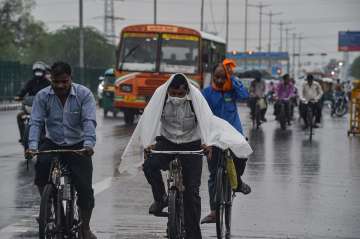Delhi Monsoon: Why onset of rains getting more unpredictable every year?
While several other parts of the country were battered by having rains, floods, and even cloud bursts, Delhi kept waiting to beat the heat.

Delhi Monsoon Rains: After several faulty predictions by the Indian Meteorological Department (IMD) about the onset of the Southwest Monsoon in Delhi, rains finally arrived in the region on July 13. The year 2021 saw a significant delay in monsoon as far as the national capital is concerned. While several other parts of the country were battered by having rains, floods, and even cloud bursts, Delhi kept waiting to beat the heat.
While Himachal Pradesh and Uttarakhand experienced heavy rainfall and floods, Jammu and Kashmir's Ganderbal witnessed a cloudburst that led to flash floods in the area. Earlier in May, tropical Cyclone Taukte hit several parts of the country like Kerala, Odisha, West Bengal, and Maharashtra leading to red and orange alerts being issued by the weather department. Even if one excludes hilly and coastal areas, states like Uttar Pradesh, Rajasthan, and Madhya Pradesh also witnessed heavy rainfall. In UP's Sonbhadra district, three boys were washed away amid perpetual 48-hour rains. In three states combined, lightning and thunder killed close to 90 people in the month of July.
This pattern, where several parts of the country witness unmanageable rains while the national capital awaits a drizzle, is not new. Delhi-NCR struggles to beat the heat and awaits monsoon longer than most states almost every year.
Also Read: Delhi rains: Relief from heat as monsoon hits city, waterlogging leads to traffic snarls
In comparison to the year 2020, the monsoon was delayed here by more than a month. Last year, the monsoon arrived on June 1, but overall the season did not record as much rain. Delhi had recorded 576 mm rainfall against the usual 624 mm last year.
In 2019, when the rest of India witnessed "above-normal monsoon" with 10 percent more rainfall than usual, Delhi recorded 38 percent rainfall deficiency, the lowest rainfall in the city since 2014, according to India Meteorological Department. In 2018, the monsoon arrived in Delhi on June 28 according to IMD’s records. Delhi witnessed surplus rainfall-- 770.6 mm in 2018 and 672.3 mm in 2017. The IMD had recorded 524.1 mm of precipitation in 2016. In June 2019, Delhi had recorded just 11.2 mm rainfall against the normal of 65.5 mm -- a deficiency of 83 percent.
Reason behind delay in monsoon in Delhi-NCR
This year, IMD had predicted the onset of the monsoon season as early as June 15, and later changed it to June 27. Following this, the department kept predicting rains in the region. The weather body’s string of missed monsoon forecasts began on June 11. IMD announced that the arrival of monsoon in Delhi, along with other parts of northwest India, had advanced by at least 12 days.
However, it is important to note why monsoon often gets delayed in the national capital. 2021 broke all records as rains gushed the city in mid-July as opposed to June-end like most previous years.
The IMD said the delay in the advancement of the monsoon over the Capital was mainly due to no formation of a low-pressure area over the Bay of Bengal, no presence of monsoon trough at mean sea level near Delhi, and 5-6 western disturbances that moved west to east across north India, which dominated the monsoon easterlies.
Delayed rains and climate change
India has witnessed a change in monsoon patterns over the years as climate disruptions take a toll on the system in the subcontinent. Steven Clemens, who is a professor of geological sciences at Brown University in the US, augmented a study that analyzed monsoon over the Indian subcontinent. The key finding is that over the past 900,000 years, whenever the CO2 levels in the atmosphere have gone up, monsoon precipitation over South Asia has become both more intense as well as more unpredictable. This supports the prediction of other studies which have stated that the Indian monsoon is entering a period of heavier and wildly unpredictable rainfall as greenhouse gas (GHG) emissions increase.
The study reaches its conclusion by studying sediment core samples drilled from the floor of the Bay of Bengal in 2014.
Power Consumption
Monsoon in India boosts the economy as the agriculture sector highly relies on ample rains for crop cultivation. However, delayed monsoon not only affects crops but significantly increases power consumption. This increase is more evident in urban areas as the heat hits harder here.
India's power consumption grew nearly 18 percent in the first week of July to 30.33 billion units (BU) compared to a year ago and returned to pre-pandemic level mainly due to easing of lockdown curbs and delayed monsoon, according to power ministry data. In Delhi, amid the delay in monsoon and rising mercury, the peak power demand in Delhi had jumped by over 30 percent since June 20, official data from State Load Dispatch Centre (SLDC) showed.